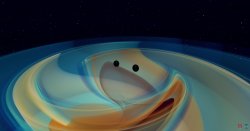A “bang” in LIGO and Virgo detectors signals most massive gravitational-wave source yet
A binary black hole merger likely produced gravitational waves equal to the energy of eight suns.
Posted in: Physics, Science and Technology

Gravitational waves are ripples in the fabric of space and time produced by colliding black holes or other cosmic collisions involving dead stars. Predicted by Einstein’s general relativity, these ripples were first discovered in September 2015 by the National Science Foundation’s Laser Interferometer Gravitational-wave Observatory (LIGO), a pair of identical, 4-kilometer-long interferometers in the United States. Now, the international LIGO/Virgo collaboration—-which includes three Montclair State faculty members—-have detected a signal from the most massive black hole merger yet observed in gravitational waves. The product of the merger is the first clear detection of an “intermediate-mass” black hole, with a mass between 100 and 1,000 times that of the sun.
The detected signal, labeled GW190521, was generated by two black holes that collided roughly 17 billion light-years away, making it one of the most distant gravitational-wave sources detected so far. This newest merger appears to be the most massive yet, involving two inspiraling black holes with masses about 85 and 66 times the mass of the sun. The merger created an even more massive black hole, of about 142 solar masses, and released an enormous amount of energy, equivalent to around 8 solar masses.
“This discovery is especially significant because it provides the best evidence yet for black holes in the so-called ‘intermediate-mass’ range—-those larger than 100 solar masses but smaller than 100,000 solar masses,” says Marc Favata, chairperson of the Physics and Astronomy Department and member of the LIGO team.
The signal, resembling about four short wiggles, is extremely brief in duration, lasting less than one-tenth of a second. The LIGO-Virgo team has also measured each black hole’s spin and discovered that as the black holes were circling ever closer together, they could have been spinning about their own axes, at angles that were out of alignment with the axis of their orbit. The black holes’ misaligned spins likely caused their orbits to wobble, or “precess,” as they spiraled toward each other.
“The heavier of the two black holes that coalesced is an exciting object in its own right,” says Shaon Ghosh, also a LIGO team member and the latest Assistant Professor to join the Physics & Astronomy Department. “The analysis confidently reveals that this object is heavier than 65 solar masses. Theoretical models predict that black holes between about 65 and 120 solar mass cannot be created from the collapse of massive stars. This is the first black hole found with a mass in this regime, and its origin is a bit of a mystery.” Prof. Ghosh currently co-leads the team responsible for the rapid release of data on gravitational-wave detections, allowing astronomers to scan the same sky regions with telescopes looking for electromagnetic emission from the gravitational-wave event.
“The universe continues to amaze us with gravitational-wave signals from surprising sources, making us refine our understanding and theoretical predictions for the existence of these objects,” says Rodica Martin, Assistant Professor of Physics and one the LIGO team members who helped construct the LIGO optical systems. Building even more sensitive detectors will open up the window of exploration to events that we didn’t consider or predict.” Prof. Martin and her students Claudia Barone, John Notte, and Jonathan Reyes are currently working on designing and testing optical components that will be used in future upgrades to the LIGO detectors.
The international team of scientists, who make up the LIGO Scientific Collaboration (LSC) and the Virgo Collaboration, have reported their findings in two papers published on Wednesday, September 2, 2020. One, appearing in Physical Review Letters, details the discovery, and the other, in The Astrophysical Journal Letters, discusses the signal’s physical properties and astrophysical implications.
This research was funded by the U.S. National Science Foundation.
Additional information about the gravitational-wave observatories
LIGO is funded by the NSF and operated by Caltech and MIT, which conceived of LIGO and lead the project. Financial support for the Advanced LIGO project was led by the NSF with Germany (Max Planck Society), the U.K. (Science and Technology Facilities Council) and Australia (Australian Research Council-OzGrav) making significant commitments and contributions to the project. Approximately 1,300 scientists from around the world participate in the effort through the LIGO Scientific Collaboration, which includes the GEO Collaboration. A list of additional partners is available through the LIGO Census.
The Virgo Collaboration is currently composed of approximately 520 members from 99 institutes in 11 different countries including Belgium, France, Germany, Hungary, Italy, the Netherlands, Poland, and Spain. The European Gravitational Observatory (EGO) hosts the Virgo detector near Pisa in Italy, and is funded by Centre National de la Recherche Scientifique (CNRS) in France, the Istituto Nazionale di Fisica Nucleare (INFN) in Italy, and Nikhef in the Netherlands. A list of the Virgo Collaboration groups can be found at http://public.virgo-gw.eu/the-virgo-collaboration/. More information is available on the Virgo website.
For more information:
- GW190521 announcement at the LSC website
- GW190521: A Binary Black Hole Merger with a Total Mass of 150 M_o (discovery paper). Published in Phys. Rev. Lett. 125, 101102 (2020)
- Properties and Astrophysical Implications of the 150 M⊙ Binary Black Hole Merger GW190521. Published in Astrophys. J. Lett. 900, L13 (2020)
